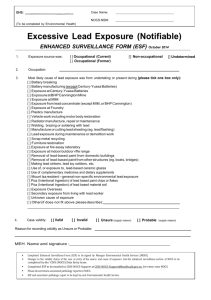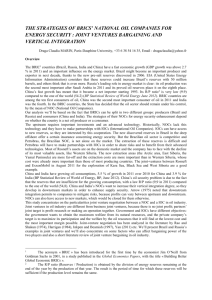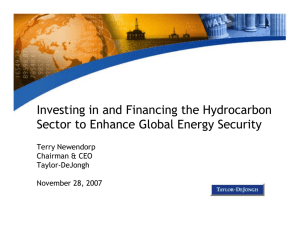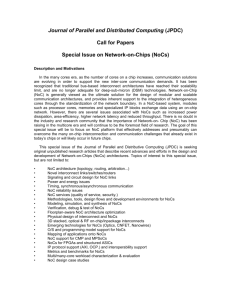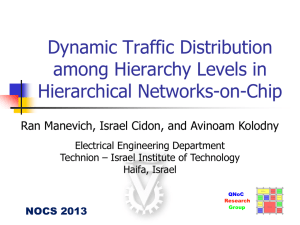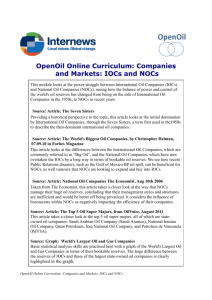POLICY EUROPEAN
advertisement
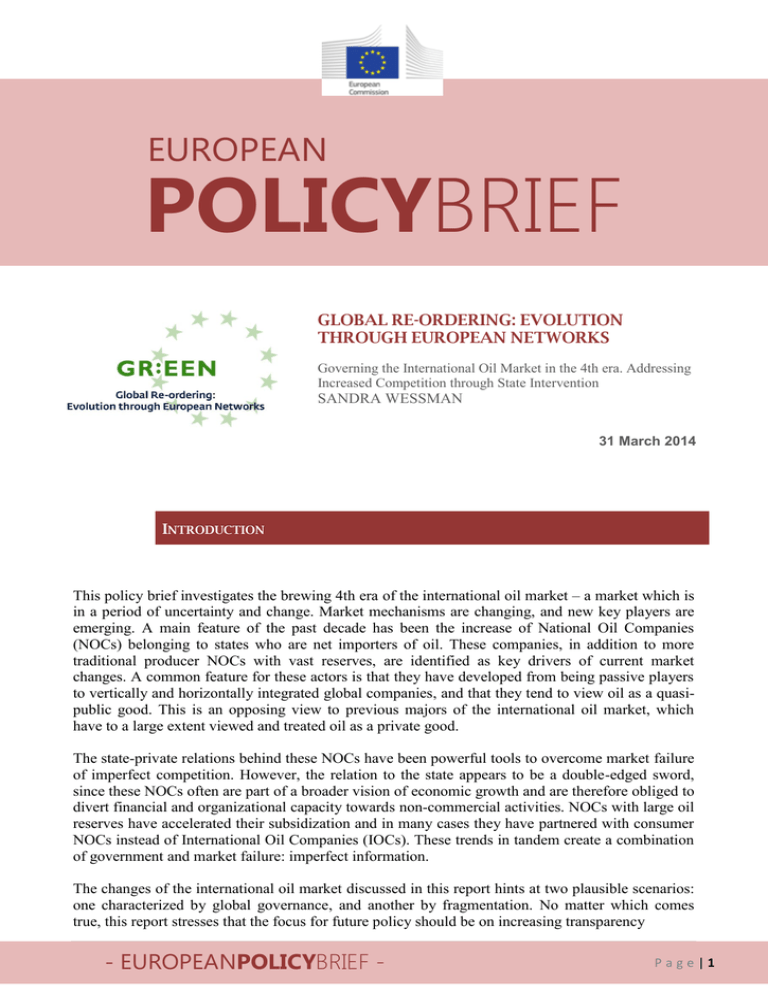
EUROPEAN POLICYBRIEF GLOBAL RE-ORDERING: EVOLUTION THROUGH EUROPEAN NETWORKS Governing the International Oil Market in the 4th era. Addressing Increased Competition through State Intervention SANDRA WESSMAN 31 March 2014 INTRODUCTION This policy brief investigates the brewing 4th era of the international oil market – a market which is in a period of uncertainty and change. Market mechanisms are changing, and new key players are emerging. A main feature of the past decade has been the increase of National Oil Companies (NOCs) belonging to states who are net importers of oil. These companies, in addition to more traditional producer NOCs with vast reserves, are identified as key drivers of current market changes. A common feature for these actors is that they have developed from being passive players to vertically and horizontally integrated global companies, and that they tend to view oil as a quasipublic good. This is an opposing view to previous majors of the international oil market, which have to a large extent viewed and treated oil as a private good. The state-private relations behind these NOCs have been powerful tools to overcome market failure of imperfect competition. However, the relation to the state appears to be a double-edged sword, since these NOCs often are part of a broader vision of economic growth and are therefore obliged to divert financial and organizational capacity towards non-commercial activities. NOCs with large oil reserves have accelerated their subsidization and in many cases they have partnered with consumer NOCs instead of International Oil Companies (IOCs). These trends in tandem create a combination of government and market failure: imperfect information. The changes of the international oil market discussed in this report hints at two plausible scenarios: one characterized by global governance, and another by fragmentation. No matter which comes true, this report stresses that the focus for future policy should be on increasing transparency - EUROPEANPOLICYBRIEF - Page|1 EVIDENCE AND ANALYSIS INTRODUCTION National Oil Companies have taken over the driver’s seat of the international oil market. By looking into the rear window, we can learn from history how previous drivers of change have influenced the international oil market and its governance. An important parameter for the choice of path at the oil market governance crossroad is what type of good oil is in the view of the driver, notably as whether it is seen primarily as a public or a private good. The state-private relationships currently in the driver’s seat view oil as a quasi-public good, the common denominator being the availability to citizens. The road we are on may lead to a path of fragmentation, as drivers search for matching needs and wants. However, in a long-term perspective, if road-signs are followed, the path may be one of tighter global governance, in particular for transparency. Different paths require different policies among the actors in the passenger seat. The passengers in this case are represented by the west, in particular the European Union, depending on the desired outcome there are different policy alternatives. Diversification of energy sources and taking a leading role on global governance of oil market transparency should be the core policy focus for the European Union. In order to make sense of where the road may lead us, this report will briefly describe previous eras of the oil market, investigate current players and discuss the future road. The report is divided into three parts, where the first describes previous eras of the international oil market, giving an understating of previous goals and means of key drivers. The second part elaborates on the key drivers of the fourth era, drawing on goods theory in order to understand new government failures and old market failures. The third part – on policy implications – is a discussion on what effects this new set-up has on the future of the international oil market and lastly what this means for future policy makers. ERAS IN THE HISTORY OF THE OIL MARKET GOVERNANCE The paragraphs that follow provide a concise summary of previous eras of the international oil market, followed by a summary of the collective knowledge regarding the fourth era. With table 1 as guidance, key actors of each era will be presented together with their view of oil as a good, their motive for the pursued path and what consequences this has had for the international oil market. - EUROPEANPOLICYBRIEF - Page|2 Table 1: Eras of the post WWII international oil market Era Key actors Good Motive Seven sisters Strategic Security of Post war period supply 1970s- 1980s OPEC Strategic 1980s-1990s BP, Shell, Exxon etc. Private good 2000s Net importer NOCs Toll / common / NOCs with vast pool reserves Nationalism, economic rent, politics Efficiency Economic growth /domestic politics Consequence Demand-side capture economic rent Supply-side capture economic rent Market concentration, volatility Increased competition / Lack of transparency The Postwar Period The Second World War revealed the strategic importance of oil and its significance to power and economic growth. By 1948 the U.S had become a net importer of oil, and the western world became dependent on International Oil Companies (IOCs) to supply "foreign oil" to cover domestic demand (Yergin 1991). This resulted in a state-centric postwar era, which was driven by the west through the Seven Sisters (Claes 2001). The steady increase in demand and low production costs in the Middle East generated great profits for the Seven Sisters, and ultimately security of supply for western governments (Fattouh and Van der Linde 2011: 26). In essence this era was characterized by the Seven Sisters as the key players with the motive to secure supplies of oil which was seen as a strategic good. This set-up led to a demand-side capture of rent. In more general terms, a state-centered approach is based on two assumptions. The first assumption is that in some cases protectionism can raise social welfare; the second holds that governments can operate independent from interest group pressure (Oatley 2012). The OPEC Era Another form of state-centered approach had been brewing in resource-rich countries. The main underlying causes were the rise of ‘permanent sovereignty’ over natural resources, dissatisfaction with the concession terms agreed in the previous period, and rising oil demand (Stevens 2008). There was a great dissatisfaction among the producing countries over the distribution of profits (economic rent) from the industry. In many cases IOCs paid more in taxes on consumer markets than they did in royalties to host governments (Yergin 1991:431). The creation of OPEC, the nationalization of resources and the creation of National Oil Companies (NOCs) in the 1970s was for producing countries a way to affirm their independence in relation to foreign interests and an assertion of independence (Noreng 2006). By October 1973, producer governments took over the prerogative of oil prices and unilaterally announced increases to the price. This was the first oil shock (Stevens 2008). All in all, the era which peaked in the late 1970s and early 1980s was an era where OPEC were the key players, driven by nationalism and unfairness in the distribution of rents, and with a view of oil as a strategic good for both economic and political reasons. The consequence was a shift of rent captured from the demand to the supply-side. - EUROPEANPOLICYBRIEF - Page|3 From 1983-1984 OPECs role as a price-setter started to be diminished for two major reasons; a halt in oil demand and new producer competition outside of OPEC (Claes 2001). The way that OPEC influenced the oil market in its golden years and up until the mid 1980s can be characterized by price-setting, whereas since 1986 the strategy has been to produce quotas (Wirl 2012). The Third Era – Oil as a private commodity With abundant supply, many states no longer considered oil a strategic good which had to be under state control, but began to view it as a commercial commodity with private good characteristics. The Washington consensus and the fall of the Soviet Union finalized the arguments for privatization and deregulation. NOCs were criticized for being ineffective due to conflicting objectives imposed by governments and rent seeking bureaucrats (Stevens 2008). During the 1980s the entire pricing system changed through a clear shift from long-term contracts to spot prices (Claes 2001). The futures and forward markets exploded, and the free market exchange became the new price-setter. By the mid-1980s North Sea crudes, particularly Brent, was a major feature of an increasingly price-transparent market. Contract prices of other crudes came to be fixed by reference to the price of Brent, subject to appropriate adjustments for quality and location (Parra 2010). World oil prices has since been set by reference to the prices of the marker crudes; Brent, WTI and Dubai. The Gulf War was a turning point in producer-consumer relations, most likely because it proved how sensitive the global market still was to such supply shocks. On October 1, 1990 in the UN General Assembly, the Venezuelan President Perez called for an urgent meeting of producers and consumers. He claimed that the arrangement at the time only would favor speculators and opened up for a dialogue between OPEC and the International Energy Agency (IEA). The first meeting took place in Paris in the summer of 1991 and these meetings are now held on an annual basis under the name of the International Energy Forum (IEF) (Fattouh and van der Linde 2011). Figure 1: Average yearly oil prices in US dollars, 1980-2012 120.00 100.00 80.00 60.00 Dubai Brent 40.00 WTI 20.00 0.00 Source: BP Statistical review 2012 Throughout the 1990s both financial and physical reserves were gradually concentrated among fewer companies. This trend of mergers and acquisitions intensified at the turn of the next decade; from 45 IOCs in 1998 to only 16 remaining in 2004 (Claes 2001:85). The companies that came out - EUROPEANPOLICYBRIEF - Page|4 of mergers were not only bigger but also capable of larger and more complex projects than ever before (Yergin 2011:105). All in all the third era brought a new approach to oil market governance; oil was considered a private good with the free market exchange as a price setter. The motive to increase efficiency in the industry and thereby new key players and drivers of change were created such as BP and Shell. The most significant consequences were a market concentration and price volatility. The fourth era – trends and findings The fourth era of the international oil market began around the turn of the millennium and this section sheds light on key changes to key market conditions; actors, transparency and entry barriers. The most significant change during this period is a new constellation of demand sided actors; the demand of the largest consumers such as U.S and Japan has been stagnating, whereas new large consumers are emerging, in particular the BRIC countries. Table 2 illustrates the top ten consuming countries since 1995. The table also sheds light on the fact that large producers have also increased their domestic demand. Moreover, the new major consumers are all represented by NOCs. Table 2: Top 10 consumers of oil TOP 10 consumers 1995 in million barrels per day USA 17,72 China 3,39 Japan 5,75 India 1,58 Russian Federation 3,10 Saudi Arabia 1,30 Brazil 1,78 South Korea 2,02 Germany 2,87 Canada 1,76 Source: BP statistical review 2000 2005 2011 19,70 4,77 5,54 2,26 2,55 1,58 2,04 2,26 2,75 1,92 20,80 6,94 5,33 2,57 2,62 1,97 2,07 2,31 2,59 2,23 18,84 9,76 4,42 3,47 2,96 2,86 2,65 2,40 2,36 2,29 Even though resources are scattered across the globe there are a few countries such as Saudi Arabia, Venezuela and Iran that hold an immense amount of reserves, see table 3. Furthermore it is estimated that 90% of reserves are nationalized (National Petroleum Council 2007). Reserves not nationalized are most likely to be found in a difficult geology such as ultra-deep seas and the Arctic. - EUROPEANPOLICYBRIEF - Page|5 Table 3: 4 top ten producers and reserves Top 10 producers 1995 2000 in million barrels per day Saudi Arabia 9,09 9,44 Russian Federation 6,24 6,47 USA 8,32 7,73 Iran 3,74 3,85 China 2,99 3,26 Canada 2,40 2,72 United Arab Emirates 2,40 2,62 Mexico 3,05 3,46 Kuwait 2,13 2,24 Iraq 0,53 2,61 Top 10 Proven reserves in billion barrels 1995 2000 Venezuela 66,3 76,8 Saudi Arabia 261,5 262,8 Canada 48,4 181,5 Iran 93,7 99,5 Iraq 100,0 112,5 Kuwait 96,5 96,5 United Arab Emirates 98,1 97,8 Russian Federation n/a 68,5 Libya 29,5 36,0 Nigeria 20,8 29,0 Source: BP statistical review 2005 2011 11,03 9,44 6,90 4,18 3,64 3,04 2,98 3,77 2,65 1,83 11,16 10,28 7,84 4,32 4,09 3,52 3,32 2,94 2,87 2,80 2005 80,0 264,2 180,5 137,5 115,0 101,5 97,8 80,2 41,5 36,2 2011 296,5 265,4 175,2 151,2 143,1 101,5 97,8 88,2 47,1 37,2 Transparency has always been a challenge for the oil market. There are some inherent elements that explain it, such as the impossibility of knowing how much is left in the ground. However, the last few years the research frontier hints at two opposing trends. On the one hand, as NOCs who lack comprehensive reporting standards and regulations are increasing their market share, and thereby decreasing the overall transparency of the global market. On the other hand, we have seen both voluntary and regulatory interventions to correct for the lack of transparency; Joint Organisations Data Initiative (JODI) and Extractive Industries Transparency Initiative (EITI) are examples of institutional frameworks designed for resolving transparency issues and sharing of best practices. The most significant entry barriers in the current decade of the oil market are government policy and specialization. Government policy refers to the nationalization of resources, and the market dominance of NOCs in the domestic market created by protective policies. The second entry barrier is specialization, both in terms of technology and investments required. Both entry barriers apply to IOCs and NOCs. A combination of high oil prices and limited access to reserves has pushed many oil companies in non-OPEC countries to explore new frontiers (Fattouh and van der Linde 2011). New frontiers are found in ultra-deep waters along the Brazilian coast, under the melting ice of the Arctic and in unconventional sources. Hence, compared to ten or twenty years ago, both of these barriers have lowered for NOCs as they have increasingly received support from their governments, both financially and politically. - EUROPEANPOLICYBRIEF - Page|6 In essence, the new key players are NOCs: both producer-NOCs in countries with vast reserves and the new consumer-NOCs. So far the consequences appear to be increased competition, combined with a new dimension to the problem of lack of transparency in the international oil market. Table 4 summarizes these conclusions. Table 4: Changes to market mechanisms during the 2000s Market mechanism Comment Actors Increase of demand side actors whereas supply remains stable Transparency Increased cooperation and regulatory measures for stock listed companies on one hand. Increase of state-owned companies that lack reporting standards on the other. Entry barriers Regulation by host governments and specialization Price-setting Free market exchange remains as price setter WHAT TYPE OF GOOD IS OIL IN THE EYES OF THE KEY DRIVERS OF CHANGE? NOCs play an increasingly important role in the global oil market. Even though many variations exist, there are two large groupings of NOCs; traditional and partial. Traditional NOCs have strong ties to the government and are often part of a wider strategic and economic perspective, such as PdVSA and Saudi Aramco. Whereas partial NOCs are a hybrid form of traditional NOCs and more commercially driven IOCs, such as Petrobras and CNPC. These two groups are drivers of supply and demand, the former due to its vast reserves and the latter for their increasing demand. These actors have a different view, motive and approach than previous key players of the international oil market. This section turns the focus to public goods theory, and elaborates on the effects for the international oil market that result from new key players that view oil as a different type of good. Table 5 summarizes the four ideal-types of public/private goods, as used in this policy report. Table 5: Public and private goods Non-excludable Pure public good Non-rival Quasi-public: Common pool Rival Excludable Quasi- public : Toll good Pure private good Case studies performed on key NOCs revealed a considerable variety of practices, shedding light on common features and differing means to achieving their goals. Consumer NOCs are increasingly looking at corporate governance models of for example Statoil, giving the company corporate autonomy to explore business opportunities in order to become vertically and horizontally global companies. Whereas domestic politics of countries with vast reserves prefer to view their NOCs as an arm of the government, table 6 illustrates this divide. - EUROPEANPOLICYBRIEF - Page|7 Table 2: Corporate governance Corporate autonomy State control Petrobras Saudi Aramco PDVSA ONGC CNPC Rosneft Another divide among NOCs is the extent to which they have to carry out non-commercial activities. In countries with vast reserves, NOCs are often seen as cash-cows to pay for social expenditure and subsidization of oil as it tends to be seen as a common pool good, which should be available to everyone. On the other hand, for many consuming NOCs, that do not hold these reserves, the aim of the NOCs are rather to secure supplies, rather than subsidizing it, in other words more of a toll good, table 7 illustrates the divide among the NOCs studied. Table 3: Non-commercial activities Consistent Transparent Heavy burden Inconsistent Petrobras Saudi Aramco PDVSA ONGC CNPC Rosneft In sum, new key players view oil as a good which is either common pool good as a result domestic politics or as a toll good due to its vitality for economic growth. - EUROPEANPOLICYBRIEF - Page|8 Oil as a toll good For many owners of net-importing-NOCs, oil has traits of a toll good; the government is trying to create a good which should be close to non-rivalry to its consumers. Oil is too important to be entirely left to market forces, yet it is increasingly seen as an excludable good as finances are directed towards increasing supply rather than subsidizing consumption. The creation of partial NOCs is seen as the most efficient allocation of resources to provide secure supplies of oil. This form of state-intervention is exemplified by the collaboration between the Chinese state and CNPC. As China became a net importer of oil in 1993, the government enforced sweeping reforms during the late 1990s in order to change the Chinese oil industry and to enhance Chinese oil companies to be competitive with western IOCs (Jiang 2012). One of those reforms was a forced swap of assets between CNPC (traditionally upstream) and Sinopec (traditionally downstream), the motive behind this reform was to create two fully vertically integrated companies. China’s going abroad strategy has been launched in five phases, the fifth phase was launched in 2002 and is still ongoing. Table 8 shows the progress of the Chinese government – CNPC partnership. Table 4: Horizontal integration, China National Petroleum Corporation 1993 1995 1997 1999 2000 2001 2002 2003 2004 2005 2006 2007 2008 2009 2010 2011 2012 Peru Canada Thailand Sudan Venezuela Kazaksthan Myanmar Turkmenistan Indonesia Malaysia Azerbaijan Oman Syria Chad Algeria Niger Russia Equador Tunisia Mauritiana Uzbekisthan Iran Libya Nigeria Equtorial Guinea Turkmenistan Iraq Costa Rica Qatar Singapore PSC Canada Service Contract Taiwan Aquistion Australia Concession Scotland Strategic alliance France Joint Venture Cuba Consortium United Arab EmiratesPurchase agreement - EUROPEANPOLICYBRIEF - Page|9 Oil as a common pool good In those countries with vast reserves, Russia being the exception, oil appears to be close to a common pool good. The public is enjoying close to free consumption of oil, subsidization rates have exploded and can be as high as 80% of the price. This courtesy has increased the use of oil, and has created a lock-in effect. For example countries like Saudi Arabia are climbing the lists of top consuming countries. Furthermore this often leads to poor re-investment rates, not only with regard to increasing production but also to maintaining a stable supply (PIW, 2013). An example where oil is motivated as a common pool good is Venezuela. When Chavez gained presidential power in December 1998, he issued policy changes both regarding the internal structure of PdVSA as well as standpoints on more restrictive production quotas in the OPEC cooperation (Tordo, Tracy, and Arfaa 2011). Since Chavez came to power cooperation with foreign companies have been more restrictive (Yergin 2011:116). According to Venezuelan law PdVSA is required to have a minimum 60 percent interest in any crude-oil exploration. Furthermore, PdVSA enjoys a monopoly position in the downstream sector as it operates all pipeline, storage, and cabotage operations. Furthermore, the oil price in Venezuela is part of the domestic politics and it is heavily subsidized. In 2011 the average subsidization rate in Venezuela was 80%, representing 8.6 % of GDP (IEA 2012). Furthermore, noncommercial obligations are estimated to be $14 billion annually. PdVSA´s transformation under Chavez is clearly a part of a broader political agenda and a way to control domestic politics, for example most of the social spending is funded by PsVSA (Hults 2012:435). A major downside of all these non-commercial burdens is that PdVSA is unable to make necessary investments in new and existing projects. Furthermore, in 2008 the government enacted a windfall profits tax of 50 percent when Brent crude rises above $70 per barrel and 100 percent when it rises above $100 (Gallegos and Luhnow 2008). In essence, instead of reinvesting in production capacity and expansion of operations, PdVSA have chosen to spend a large share of its revenue on subsidization. This paired with a limited market access from foreign actors has led to a lack of investments. The view of oil as a common pool good among large resource holders creates a lack of investments and a lock-in effect among domestic consumers. Addressing market failure: increasing competition In the 1990s we saw the (re)creation of large IOCs, through mergers and acquisitions some of the world’s largest corporations were born. Competition authorities were concerned with the development. Meanwhile the BRICs have had tremendous economic growth since the mid 1990s. As oil is the engine of the economy, it would only be natural for them to also be involved in a larger share of the oil market. A dilemma occurred; how were their companies supposed to compete with the IOC giants? The solution was the creation and reinforcement of their NOCs, financially and politically through state intervention. This solution helped repair the market failure of imperfect competition. Through a mix of state-intervention and commercial goals NOCs, such as the previous example of CNPC, have become vertically and horizontally integrated companies of a global character. There has been a significant increase of NOC-NOC alliances, such as Saudi Aramco and PdVSA partnering with CNPC to invest in refineries (Reuters 2010) and Petrobras signing exploration contracts with African countries, such as Angola in 2010 (Bloomberg 2011). However, IOCs are still are of great importance to the market, for example they are highly valued for their expertise and are often seen as clusters of knowledge and investments. NOCs often partner with IOCs in projects requiring frontier engineering or in megaprojects, such as Rosneft partnering with Exxon to explore in the Arctic, or CNPC partnering with Shell in domestic upstream activities (PIW 2012). - EUROPEANPOLICYBRIEF - P a g e | 10 As a result, competition has increased and new alternatives for alliances and collaborations are available. In particular, these new consumer NOCs are new alternatives for producing NOCs with strong political ties that avoid collaborations with IOCs, as means of being sceptical to former imperialists. For example, during the past decade CNPC, Petrobras and ONGC have negotiated partnerships with PdVSA in the Orinoco belt (Bloomberg 2011, Oil and Gas Journal 2003). Another recent example of this is the sign of for exploration rights to CNPC in Cuba, Turkmeniztan, Uzbekistan and Sudan (James 2011, Bloomberg 2010). Creating market failure: imperfect information During the past decade there has been an intensifying concern for the lack of transparency in the oil market. The concern is based on three main aspects: the amount of oil left, distribution of economic rent, and an emerging concern with regards to non-transparent bilateral agreements. With regards to ‘peak oil’ and the amount of reserves in the ground: we have never known and most likely will never know. This fact is not only a result of unwillingness, but also a due to lacking capacity. Voluntary and cooperative efforts as well as regulatory measures have increased reporting standards of countries and companies. However, most presented facts are very difficult to verify. Consumers and citizens of producer countries would benefit from more sharing of best practices. Best practice transfers are trying to be realized through organizations such as EITI. Concerning the latter two concerns, which is the focus in this report, voluntary and regulatory measures have mainly focused on private companies. As NOCs have spread through the global value chain there is an increased chance for a drop of oil to be taken out of the ground and pass through the entire value chain without passing through any actor that by regulation is obliged to publish data to the public. Therefore, the market failure of imperfect information appears to have further worsened, and is now both a government and market failure, as such policies to battle the lack of transparency must be altered in order to efficiently target the causes. POLICY IMPLICATIONS AND RECOMMENDATIONS There appears to be two opposing, though not mutually exclusive, plausible scenarios going forward. In the first, we see an increasingly fragmented market, whereas the second represents an increase of global governance of the oil market, and the emergence of an international regime. Due to the logistics of oil, fragmentation does not necessarily have to be based on geographical criteria. Rather, it would more likely be based on partnerships to satisfy a need such as to secure supply/ demand, to avoid volatility in prices or exchange rate risks. A phenomenon that strengthens this scenario is the emergence of bilateral purchase agreements between consumer and producer NOCs/governments. From what we know, they are yet small in size, hence bilateral agreements between consumer NOCs wanting to secure supply and exporting NOCs wanting to secure (a nontransparent) income may become more frequent. In addition, volatility in prices has increased the rationale for substitutes, in particular for unconventional sources. For example the development of unconventional sources in the U.S. has now started to pay off and this is a trend that could further increase the fragmentation argument. The second plausible scenario is that we will see a more robust form of global governance emerge. An increase in the number of actors, an increased complexity, a concern for transparency and perhaps foremost a concern of price volatility on both sides of the supply chain have triggered calls - EUROPEANPOLICYBRIEF - P a g e | 11 for more global governance. To date there has not been created a rigid regime that has the capacity to involve all actors. Traditionally much dialogue has been centred around IEA and OPEC, but over the last decade countries and companies outside this dialogue have increased their significance both on the supply and demand side. The failure to be able to incorporate key players such as China, India and Russia, may lead to a collapse or at least less significance of that dialogue. For now, we do not have a clear hegemonic power of the oil market and this may also be the reason for the lack of a clear and leading regime. As previously stated, these two scenarios do not have to be mutually exclusive. Regionalization of trade does not have to stand in the way of global governance. However, if regionalization intensifies, this indicates that there are different needs and wants, putting further pressure on future policies. In a long-term perspective transparency would benefit all, as it would stabilize prices. However in order to create such global governance, all actors need to be involved, in particular those who have taken part in creating market and government failures. Therefore the primary target of future policy should be to create a forum where new key players are involved and the secondary target should be to implement both voluntary and regulatory policies that enhance transparency. The key drivers of change are identified as National Oil Companies of emerging economies and countries with vast reserves. Even though these companies vary in their corporate setup and in their relationship to the state, they do share a different view of oil as a good compared to previous majors of the market. The new hybrid state-private relationships and NOCs of the 2000s symbolize new means to secure supply and demand. By viewing oil as a quasi-public good, priced by the market, but ensuring its vital availability to emerging markets through state-intervention, vertically and horizontally integrated companies that are competitive with IOCs have been created. Insofar we can conclude that old market failures of imperfect competition appears to have diminished at the same time as the future road require policies to battle market and government failures that have worsened the lack of transparency. The focus of policy should be on increasing and strengthening transparency, reinforcing organizations such as Joint Organisations Data Initiative and Extractive Industries Transparency Initiative, and for them in turn to enable the share of best practices, data collection and surveillance. A forum for dialogue among main actors could be the International Energy Forum, where the primary focus of policy should be to get new key players on board. The West is not likely to be the rule-setter in the future, therefore in at least incorporating these new key players to existing forums, actors such as the EU will be more likely to be part of the process in creating global governance. In the case of a fragmentation, there are no clear partners for the EU and its member states. A demand-sided EU would currently find it difficult to find matching needs of suppliers. In case of this scenario becoming reality, there are two policy paths, which are not mutually exclusive. The first is to assess what the EU could do to be less vulnerable to supply shocks, such as accelerate the diversification process away from oil and increase spare capacity. The second goes back to the argument above regarding global governance, to be part of and to encourage an international regime for global governance of the international oil market. RESEARCH PARAMETERS - EUROPEANPOLICYBRIEF - P a g e | 12 This policy brief is based on the master thesis, The International Oil Market of the 21st Century: Increased Competition through State Intervention, by Sandra Wessman, for the MSc in Political Economy at the BI Norwegian Business School, during her exchange year at Central European University, as part of the GR:EEN project. PROJECT IDENTITY PROJECT NAME Global Re-ordering: Evolution through European Networks (GR:EEN). COORDINATOR Professor Shaun Breslin, The University of Warwick, Coventry, United Kingdom. E: shaun.breslin@warwick.ac.uk CONSORTIUM Universiteit van Amsterdam Amsterdam, Netherlands Boston University Boston. United States of America Université Libre de Bruxelles Brussels, Belgium University of Cape Town Cape Town, South Africa Copenhagen Business School Copenhagen, Denmark Central European University Budapest, Hungary Facultad Latinoamericana de Ciencias Sociales Buenos Aires, Argentina FRIDE Madrid, Spain Istituto per gli Studi di Politica Internationale Milan, Italy Nanyang Technological University Singapore, Singapore Norwegian Institute of International Affairs Oslo, Norway Peking University Beijing, People’s Republic of China United Nations University- Comparative Regional Integration Studies Bruges, Belgium - EUROPEANPOLICYBRIEF - P a g e | 13 University of Western Australia Perth, Australia Waseda University Tokyo, Japan FUNDING SCHEME FP7 Framework Programme, Collaborative Project, SSH – Europe facing a rising multi-polar world DURATION March 2011- February 2015 (48 months) BUDGET EU contribution: 7 944 718 €. WEBSITE www.greenfp7.eu FOR MORE Contact: General queries to green@warwick.ac.uk Contact: Project management matters to Laura Downey, L.Downey@warwick.ac.uk INFORMATION FURTHER READING All working papers, policy briefing papers and other publications are available on our website: www.greenfp7.eu/papers REFERENCES Beeson, Mark Soko, Mills andYong, Wang. 2011. ”The new resource politics: Can Australia and South Africa accomodate China?” International Affairs 87 (6): 1365–1384. Bressand, Albert. 2010. ”Future of consumer-producer cooperation”. I Global energy governance: New rules of the game, by Andreas Goldthau and Jan Martin Witte. Brookings. Claes, Dag Harald. 2001. The Politics of oil-producer cooperation. The Political Economy of Global Interdependence. WestviewPress. Dicken, Peter. 2011. ”Transnational Corporations: The primary movers and shapers of the Global Economy”. I Global shift: Mapping the changing contours of the world economy, Chapter 5. 6th uppl. SAGE Publications. Ernst & Young. 2011. Turn risks and opportunities into results: Exploring top 10 risks and opportunities for global organizations: oil and gas sector. Fattouh, Bassam, and Coby van der Linde. 2011. ”The International Energy Forum: Twenty years of producer - consumer dialogue in a changing world”. International Energy Forum. Goldthau Andreas. 2012. ”From the state to the market and back: Policy Implications of changing energy paradigms”. Global Policy 3 (2) (May): 198–209. Goldthau, Andreas. 2010. ”Energy diplomacy in oil and gas”. I Global energy governance: New rules of the game, by Andreas Goldthau and Jan Martin Witte. Brookings. Harbo, Florentina. 2008. ”The European gas and oil market: The role of Norway”. IFRI. Harks, Enno. 2010. ”The IEF and the mitigation of oil market risks”. I Global energy governance: New rules of the game, by Andreas Goldthau and Jan Martin Witte. Brookings. Henderson, James. 2012. ”Rosneft - On the road to global NOC status?” The Oxford Institute for Energy Studies. Ian Taylor. 2006. ”China´s oil diplomacy in Africa”. International Affairs 82 (2): 936–959. IEF. 2012. NOC-IOC partnerships; General guidelines for successful cooperation. Kuwait: International Energy Forum. Jaffe, Amy Myers, and Ronaldo Soligo. 2010. ”State-backed financing in oil and gas projects”. I Global energy governance: New rules of the game, by Andreas Goldthau and Jan Martin Witte. Brookings. James, Robert A, 2011 PESD (Program on energy and sustainable development. Working paper 104 Jian, Zhang. 2011. ”China´s energy security: Prospects, challenges and opportunities”. The Brookings Institution, Centre for North-East Asian Policy Studies. - EUROPEANPOLICYBRIEF - P a g e | 14 Keun-Wook Paik, Valerie Marcel, Glada Lahn, John V. Mitchell, and Erkin Adylov. 2007. TRENDS IN ASIAN NOC INVESTMENT ABROAD. London: The Royal Institute of International Affairs. Kohl, Wilfrid. 2010. ”Consumer country energy cooperation”. I Global energy governance: New rules of the game, by Andreas Goldthau and Jan Martin Witte. Brookings. National Petroleum Council. ”Energy supply”. I Facing hard truths about energy, Chapter 2. Hard truths. July 2007: National Petroleum Council. Noreng, Oystein. 2012. Crude power. IB Tauris & Co Ltd. h Noreng, Oystein. 2012. Peak oil: en ekonomisk analys. Rapport till expertgruppen för miljöstudier. Regeringskansliet, Finansdepartementet. Oatley, Thomas. 2012. ”A state-centred approach to trade politics”. I International political economy. 5th uppl. Pearson Education. Palazulelos, Enrique, and Rafael Fernandez. 2012. ”The importance of transnational corporations in the supply of oil to Europe: Implications”. Energy policy 47: 270–281. Parra, Fransisco. 2010. ”Oils new world”. I Oil politics - A modern history of petroleum, Chapter 16. I.B. Tauris. Radetzki, Martin. 2012. ”Politics-not OPEC interventions - explain oil´s extraordinary price history”. Energy policy 46: 382–385. Raphael, Sam, and Doug Stokes. 2010. ”Energy Security”. In Contemporary Security Studies, by Allan Collins. 2nd Edition. Oxford University Press. Stevens, Paul. 2008. ”National oil companies and international oil companies in the Middle East: Under the shadow of government and the resource nationalism cycle”. Journal of World Energy Law & Business 1 (1): 5–30. Tordo, Silvana, Brandon S Tracy, and Noora Arfaa. 2011. ”National Oil Companies and value creation I”. The World Bank. Umbach, Frank. 2010. ”Global energy security and the implications for the EU”. Energy policy 38: 1229– 1240. Wirl, Franz. 2012. ”OPEC strategies”. Z Engeriewirtsch 36: 227–237. Xiaojie Xu. 2007. Chinese NOCs´ overseas strategies: Background, comparison and remarks. Rice University: James A. Baker III Institute for Public Policy. Yergin, Daniel. 2011. The quest : Energy, security and the remaking of the modern world. New York: The Penguin Press. Yergin Daniel. 1991. The prize, The epic quest for oil, money and power. Simon and Schuster. Youngs, Richard. 2009. ”European Energy Companies”. I Energy Security: Europe’s new foreign policy challenge, Chapter 8. Taylor and Francis. Ziegler. Charles E. 2008. ”Competing for markets and influence: Asian national oil companies in Eurasia”. Asian Perspective 32 (1): 129–163 - EUROPEANPOLICYBRIEF - P a g e | 15
